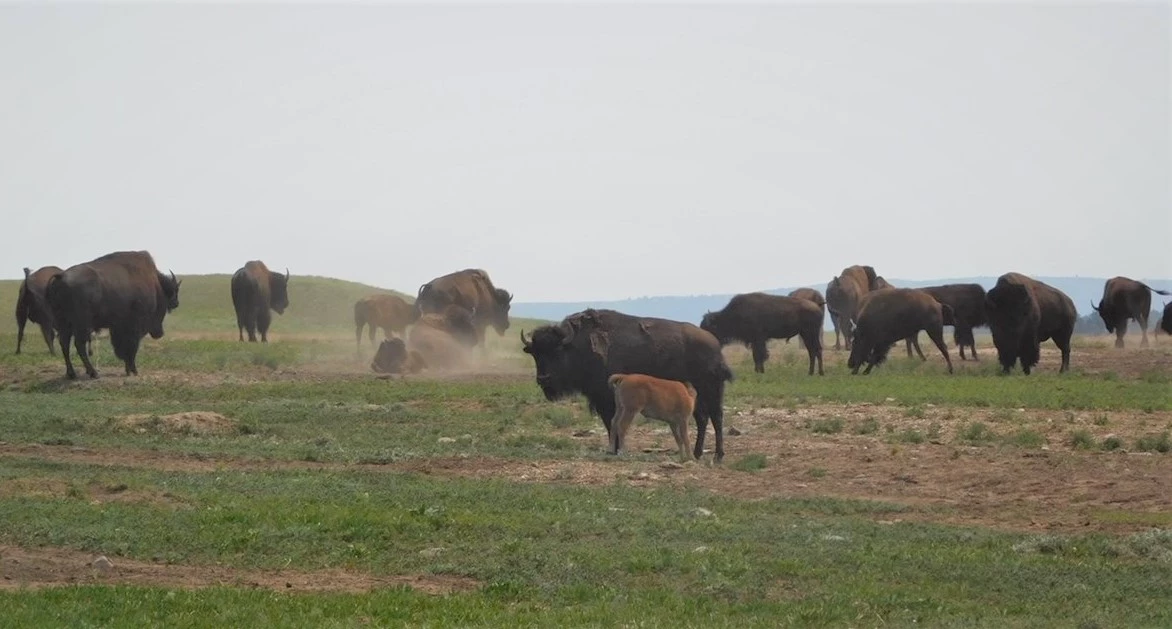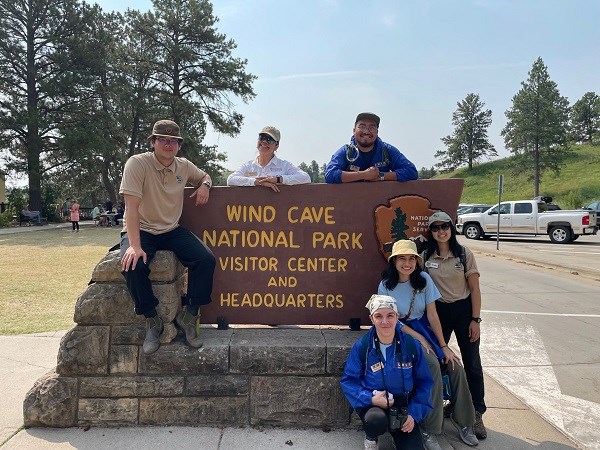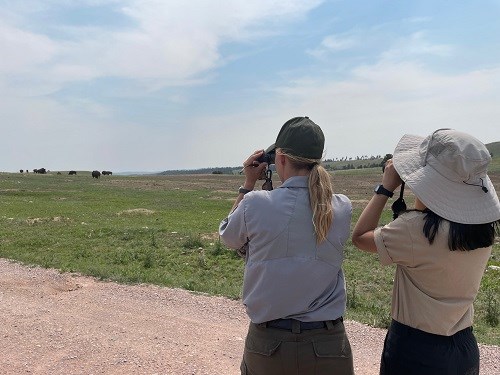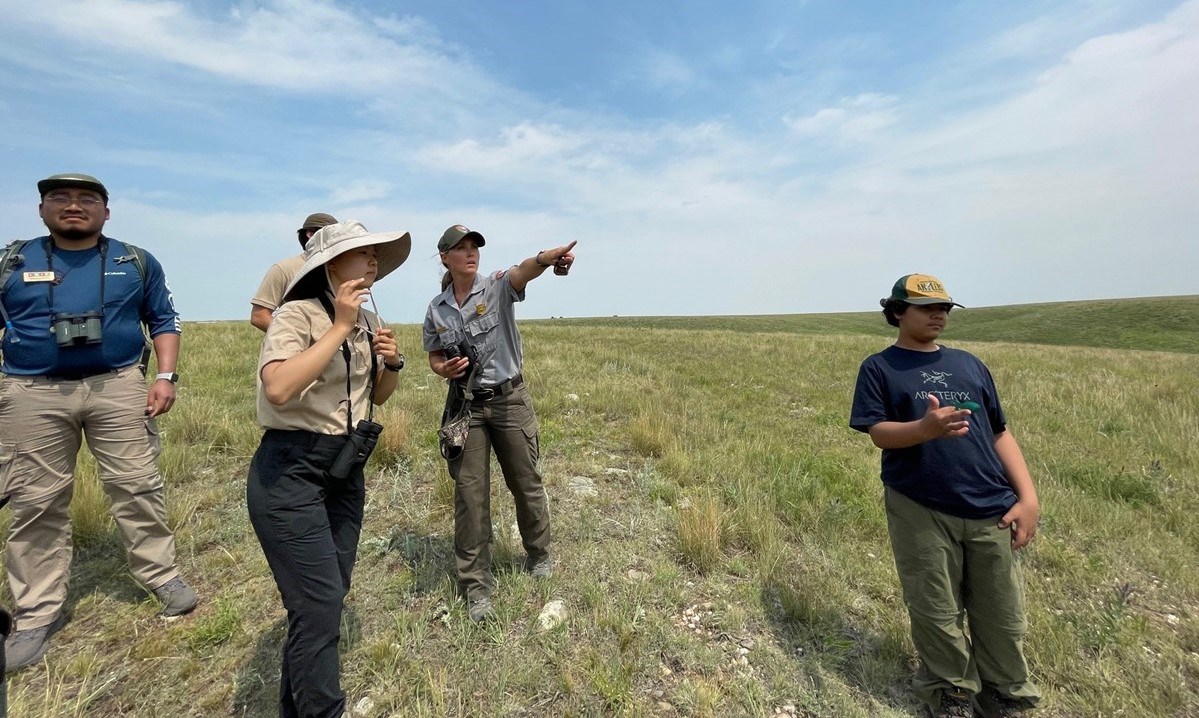Last updated: February 24, 2025
Article
Counting Bison...And New Experiences in the Latino Heritage Internship Program
By Nicole Segnini, Communications Intern, Office Of Communications

NPS Photo by Shanelle Thevarajah
What do you get when you send a Venezuelan-born, Florida resident to South Dakota to count bison? You get a very excited person who most definitely forgot to take as many pictures as she should’ve because she was looking through the binoculars for too long!
People call them fluffy cows...And now I can finally attest to that statement, ‘cause fluffy they are! This past Latino Conservation Week I was fortunate enough to see for the first time not one, but hundreds of bison at Wind Cave National Park in South Dakota (as well as hundreds more outside of the park).
I’m Nicole Segnini and I am a National Park Service intern with the Latino Heritage Internship Program (LHIP). Together with two more LHIP interns, Yuyavan Robles and Paola Hinojosa; and two Mosaics In Science interns, William Tsai and Brooke Su, we headed out to a camping trip adventure. It was filled with everything that a camping trip needs to have: s’mores, late night card games, troubles lighting up the campfire, tents that were too small, incredible night skies, bugs, and lots of wildlife.
"Sleeping in a tent..learning how to light up a fire...experiencing the silence and calmness of nature...Camping for the first time was a fascinating experience."
- Paola Hinojosa, LHIP intern with the Southwest Border Resource Protection Program

NPS Photo
The main focus of our trip was to survey bison at one of America’s oldest national parks, Wind Cave National Park. The park is one of the earliest national parks, established in 1903 by President Theodore Roosevelt. It was also the first cave ever designated as a national park. We took a Natural Entrance Tour of the cave where we learned about the cave’s discovery and exploration. Wind Cave, named for barometric winds at its entrance, is one of the longest and most complex caves in the world. Throughout the tour we were able to see the cave’s famous boxwork, a unique formation rarely found elsewhere. We went down 300 stairs (200 feet below the surface) and walked on some slippery surfaces (some of us might've fallen a few times but the cave has handrails that were very helpful).
Wind Cave is a deeply spiritual place to many people (at least 20 different native nations have ties to this incredible place). During the tour, we learned about the incredible Lakota Emergence Story, which is the Lakota people’s traditional origin story. This version of the story comes from the Cheyenne Creek community on the Pine Ridge Indian Reservation of the Oglala Lakota tribe. According to the story, the Lakota people lived underground until they were allowed to emerge onto the surface of the Earth: they were waiting until Earth was ready for them. But not only were the first humans born from Wind Cave, the first bison is believed to have come from the cave as well.
"The cave was so captivating and I enjoyed learning about the different rock and cave formations like the "popcorn"...It got me thinking of maybe challenging myself one day going caving!"
- William Tsai, MIS intern at Rocky Mountain National Park

NPS Photo
After our cave tour we headed out to “hunt bison” with the park’s wildlife biologist, Angela Jarding. And no, we didn’t actually hunt them, we just went out to look for the park’s herd so we could count how many bison, including calves, there are. We drove for a few miles around the park and encountered other wildlife throughout our bison chase. We saw prairie dogs roaming around the rolling prairie grasslands; a family of sharp-tailed grouse wandering through the grass; and we even got to see a beautiful pronghorn, one of the fastest land mammals in North America.
When we finally found the park’s bison herd, they were a bit close to us, but because they can be dangerous and unpredictable, we gave the fluffy cows their space and looked through our binoculars to enjoy the wild animals’ beauty. For me, this was the first time seeing this iconic animal. For most of us, this was the first time doing this type of conservation activity: a bison survey. That was the focus for our Latino Conservation Week activity at the park. It was a great opportunity for us to get hands-on experience to conserve and preserve our national mammal, and learn about the importance of bison studies at the park.
"Workng side-by-side with a biologist has been the most hands-on I've gotten so far. I am thankful that I got to experience this and share it with people who are just as passionate for the protection of wildlife and nature as I am."
- Yuyavan Robles, LHIP intern at the Florissant Fossil Beds National Monument
The American Bison Society sent 14 bison from the New York Zoological Gardens (now the Bronx Zoo) to Wind Cave back in 1913. An additional six bison were sent to the park in 1916 from Yellowstone National Park. It is from these bison that Wind Cave's herd is descended from. Thanks to this, the park's herd has helped reestablish bison populations around the country, and even in Mexico.
Surveying the bison and keeping count of its population at Wind Cave is important to keep the quality of the park’s habitat. Under the methods of wildlife management, the park has had to find a balance between herd size and plant communities. To do so, excess bison are rounded-up, tested for diseases, and, when possible, sent to Indian Reservations and other parks and refuges. For this, the park needs to keep track of how many bison calves are being born every year. Typically, the park gets about 70 to 90 calves, between April and May. That means the rutting, or mating, season is underway. It lasts from late June through early September with peak activity in July and August. At this time, the older bulls rejoin the herd and fight each other for breeding rights. The herd is very restless during the rut and this is when they are most dangerous.
The once almost-extinct bison population has grown significantly nationwide, but most herds remain small and isolated. Now, the goal is to ensure that the health of bison, their habitat, and their genetic, ecological and cultural importance is protected and preserved for future generations. These surveys help Wind Cave keep track of how fast the population is growing and monitor its herd to make sure the bison and their habitat are being protected and conserved for the future.

NPS Photo
By the end of this count, each of us had counted between 110 to 130 bison, and about 12 calves.
This camping trip and bison survey taught us a lot. For the biologists and wildlife lovers in our team, this was an opportunity to get involved in an important conservation effort. It was also a great time connecting with the outdoors and nature and experience a new environment. For me, someone who is not a biologist, I learned so much from my peers who are, as well as from the park rangers and biologists about things that I never thought I would be interested in (yes, I never thought bison would be this interesting and important).
National parks are incredibly special places where natural and cultural resources are protected and preserved. At Wind Cave National Park, I had the unforgettable experience of being part of this effort.
"My favorite part was meeting and hanging out with the other interns! As the only staff of color at my park, it was really refreshing to meet other interns of color and share our work experiences and love for conservation."
- Brooke Su, MIS intern at Wind Cave National Park
